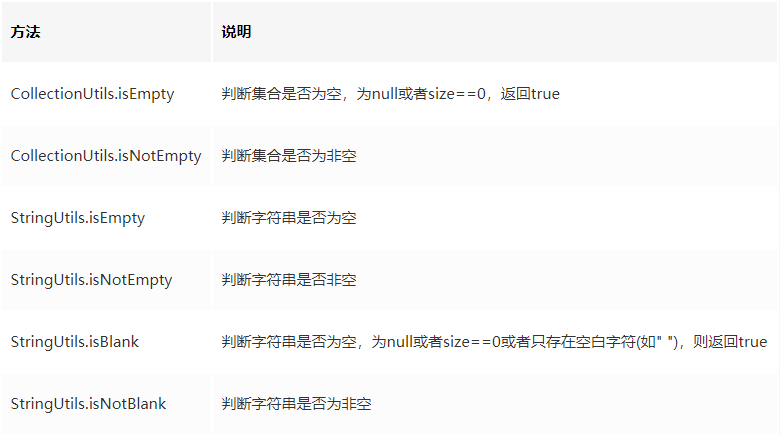Spring Boot 进行优雅的字段校验,写得太好了!
作者:何甜甜在吗
来源:juejin.cn/post/6913735652806754311
前段时间提交代码审核,同事提了一个代码规范缺陷:参数校验应该放在controller层。到底应该如何做参数校验呢
Controller层 VS Service层
去网上查阅了一些资料,一般推荐与业务无关的放在Controller层中进行校验,而与业务有关的放在Service层中进行校验。
那么如何将参数校验写的优雅美观呢,如果都是if - else,就感觉代码写的很low,还好有轮子可以使用
常用校验工具类
使用Hibernate Validate
引入依赖
<dependency>
<groupId>org.hibernate</groupId>
<artifactId>hibernate-validator</artifactId>
<version>4.3.1.Final</version>
</dependency>
常用注解说明

使用姿势
Spring Boot 基础就不介绍了,推荐下这个实战教程:
https://www.javastack.cn/categories/Spring-Boot/
需要搭配在Controller中搭配@Validated或@Valid注解一起使用,@Validated和@Valid注解区别不是很大,一般情况下任选一个即可,区别如下:

虽然@Validated比@Valid更加强大,在@Valid之上提供了分组功能和验证排序功能,不过在实际项目中一直没有用到过
Hibernate-validate框架中的注解是需要加在实体中一起使用的
- 定义一个实体
public class DataSetSaveVO {
//唯一标识符为空
@NotBlank(message = "user uuid is empty")
//用户名称只能是字母和数字
@Pattern(regexp = "^[a-z0-9]+$", message = "user names can only be alphabetic and numeric")
@Length(max = 48, message = "user uuid length over 48 byte")
private String userUuid;
//数据集名称只能是字母和数字
@Pattern(regexp = "^[A-Za-z0-9]+$", message = "data set names can only be letters and Numbers")
//文件名称过长
@Length(max = 48, message = "file name too long")
//文件名称为空
@NotBlank(message = "file name is empty")
private String name;
//数据集描述最多为256字节
@Length(max = 256, message = "data set description length over 256 byte")
//数据集描述为空
@NotBlank(message = "data set description is null")
private String description;
}
说明:message字段为不符合校验规则时抛出的异常信息
- Controller层中的方法
@PostMapping
public ResponseVO createDataSet(@Valid @RequestBody DataSetSaveVO dataSetVO) {
return ResponseUtil.success(dataSetService.saveDataSet(dataSetVO));
}
说明:在校验的实体DataSetSaveVO旁边添加@Valid或@Validated注解
使用commons-lang3
引入依赖
<dependency>
<groupId>org.apache.commons</groupId>
<artifactId>commons-lang3</artifactId>
<version>3.4</version>
</dependency>
常用方法说明

测试代码
//StringUtils.isEmpty
System.out.println(StringUtils.isEmpty("")); //true
System.out.println(StringUtils.isEmpty(" ")); //false
//StringUtils.isNotEmpty
System.out.println(StringUtils.isNotEmpty("")); //false
//StringUtils.isBlank
System.out.println(StringUtils.isBlank("")); //true
System.out.println(StringUtils.isBlank(" ")); //true
//StringUtils.isNotBlank
System.out.println(StringUtils.isNotBlank(" ")); //false
List<Integer> emptyList = new ArrayList<>();
List<Integer> nullList = null;
List<Integer> notEmptyList = new ArrayList<>();
notEmptyList.add(1);
//CollectionUtils.isEmpty
System.out.println(CollectionUtils.isEmpty(emptyList)); //true
System.out.println(CollectionUtils.isEmpty(nullList)); //true
System.out.println(CollectionUtils.isEmpty(notEmptyList)); //false
//CollectionUtils.isNotEmpty
System.out.println(CollectionUtils.isNotEmpty(emptyList)); //false
System.out.println(CollectionUtils.isNotEmpty(nullList)); //false
System.out.println(CollectionUtils.isNotEmpty(notEmptyList)); //true
自定义注解
当上面的方面都无法满足校验的需求以后,可以考虑使用自定义注解。
近期热文推荐:
1.1,000+ 道 Java面试题及答案整理(2021最新版)
2.别在再满屏的 if/ else 了,试试策略模式,真香!!
3.卧槽!Java 中的 xx ≠ null 是什么新语法?
4.Spring Boot 2.5 重磅发布,黑暗模式太炸了!
觉得不错,别忘了随手点赞+转发哦!






【推荐】国内首个AI IDE,深度理解中文开发场景,立即下载体验Trae
【推荐】编程新体验,更懂你的AI,立即体验豆包MarsCode编程助手
【推荐】抖音旗下AI助手豆包,你的智能百科全书,全免费不限次数
【推荐】轻量又高性能的 SSH 工具 IShell:AI 加持,快人一步
· 从 HTTP 原因短语缺失研究 HTTP/2 和 HTTP/3 的设计差异
· AI与.NET技术实操系列:向量存储与相似性搜索在 .NET 中的实现
· 基于Microsoft.Extensions.AI核心库实现RAG应用
· Linux系列:如何用heaptrack跟踪.NET程序的非托管内存泄露
· 开发者必知的日志记录最佳实践
· winform 绘制太阳,地球,月球 运作规律
· AI与.NET技术实操系列(五):向量存储与相似性搜索在 .NET 中的实现
· 超详细:普通电脑也行Windows部署deepseek R1训练数据并当服务器共享给他人
· 【硬核科普】Trae如何「偷看」你的代码?零基础破解AI编程运行原理
· 上周热点回顾(3.3-3.9)
2020-10-28 Spring Boot + PageHelper 实现分页,总结得很全了!